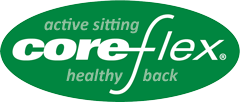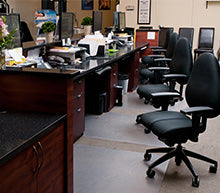Healthy Sitting Guide

Healthy sitting 101: Don’t sit with the back slumped
Healthy sitting consists of not sitting with our back slouched over, but keeping the spine within its neutral alignment.(1,2) The neutral posture for the spine is the natural position when standing upright, with three slight curves between the pelvis and the head. The lumbar spine, just above the pelvis, has a natural inward curve (lordosis) that bears the weight of the upper body very efficiently. Sitting down causes the top of the pelvis to rotate rearward, pushing the lumbar spine into an outward curve or kyphosis, which puts stress on spinal structures when maintained for hours in static sitting postures.
Research shows that most people sit in a slouched position, with the back bent into a ‘C’ shape, and the head projecting forward.(3) This position puts stress on the lumbar intervertebral discs, muscles and ligaments, and in the short term can create an unstable spine vulnerable to injury. Many researchers also propose that in the long term such injury can lead to chronic pain. The pathway from slouched sitting to the development of low back pain is under constant investigation.
Why we slouch

There are two reasons why most people end up in the slouched sitting position:
- We tend to unconsciously relax our core muscles when sitting down, and “rest” in chairs. The flexible human spine requires constant core muscle exertion to be held upright against the force of gravity, so sitting slumped is less work than sitting upright.
- Even if we consciously try to maintain a healthier, upright sitting position, our spinal support muscles quickly become fatigued, because static muscle contractions restrict blood flow, causing a rapid reduction in available oxygen and accumulation of waste products. This leads to sore, tired back muscles and a slouched sitting position.
The solution: continual change in posture
The secret to avoid the slouched sitting posture is contained in this quote from “Ultimate Back Fitness and Performance” by Stuart McGill, PhD, professor of spine biomechanics at the University of Waterloo: The ideal sitting posture is one that continually changes, thus preventing any single tissue from accumulating too much strain.
Our bodies use this strategy when standing, continually adjusting posture 2-3 times per minute (4) by shifting weight from side to side (called postural sway). This movement ensures that our postural muscles are not forced to maintain a static exertion, and do not accumulate strain.
Your Core-flex chair is designed to allow the continuation of this constant postural variation while sitting, so that your core muscles can maintain a more neutral spinal posture with less fatigue. The movement also brings nutrition into the discs, and keeps the body’s muscles active. After a few days using the chair, you will develop your own habits and patterns of movement.
Getting set up
To create the proper environment for healthy sitting, it is important to understand the basic ergonomic guidelines for chair adjustment, workspace arrangement, keyboard and monitor height, etc. Please adjust your Core-flex chair to a comfortable fit as described in the Lifeform Reference Guide, or in this video. It's also important to keep the armrests adjusted to the correct height, so that they reduce the strain on your spinal support muscles. Here are some links to standard ergonomic office guidelines:
Sit with your core engaged
Next, find your neutral spine position while sitting. Sit all the way back in your chair, with your lower back against the backrest. By using the backrest to support your pelvis and lower back, it’s easier to keep your spine in a neutral posture. You’ll need to be conscious of “lifting” your torso slightly, keeping your shoulders back, chest open, and head up. The spine should not be rigid or straight, but comfortably upright. Try to learn the difference between the slouched position (with a relaxed core), and the upright position (with engaged core muscles). Even if you maintain full contact with your backrest, you need to feel the internal muscular support for your spine, which would be maintained automatically if you were standing.
If you were sitting still in a normal chair, it would prove difficult to maintain this core muscle exertion. But with the constant postural shifts on your Core-flex chair, you'll find that it easier to maintain neutral posture. As you become accustomed to maintaining core muscle engagement throughout the day, you’ll be amazed at how many aches and pains disappear. If you're unsure of how to engage your core muscles, please refer to Dr. Pynt’s article “Engaging the core when sitting”.
Position of feet
Now, position your feet to give the best range of movement. Starting with your knees at a 90 degree angle and feet flat on the ground, pull your feet back about two inches so that the balls of your feet are directly below your knees. Now you can move your seat by raising one thigh while lowering the other, and by alternately extending your feet at the ankle (plantar flexion) to drive the legs' movement. Note: ergonomists usually recommend keeping the knees at a 90 degree angle, but this is based on the assumption that a person is sitting motionless, and bending the knees further might decrease blood flow to the lower leg. As any ergonomist knows, the best way to increase blood flow is to move the legs and activate muscles, so this restriction on static sitting does not apply in your Core-flex chair.
You are now ready to move!

The simple alternating movement of the legs while sitting in your Core-flex chair is similar to the motion of walking, which shifts core muscle exertion from side to side. Try to keep your head and arms stable, and your core muscles engaged, while moving your legs and pelvis. This promotes healthy lateral flexing of the lumbar spine, and yet causes no distraction from your desk work. Always use your armrests when using the mouse or keyboard, since this decreases strain on the spine.
You may have to remind yourself to move at first, but very soon it becomes automatic and unconscious. You should continue to use the chair recline as a means of postural variation, if you were in the habit of doing so, just add in the flexing of the seat. Your body will remember to make small movements several times per minute, which it already does while you’re standing. Each small movement re-engages your core, boosts your metabolism, and increases comfort by shifting stress.
Another advantage of your Core-flex chair is that you can sit with the seat halves slightly offset, and with the lower leg comfortably extended. This position opens the hip-thigh angle and helps lengthen the hamstring muscle.
Here are some further guidelines about what to expect in the first days and weeks while using your Core-flex chair, based on customer feedback:
-
As with any new activity, don’t overdo it to begin. The idea is not to get aerobic exercise, but to stimulate your core muscles and keep your back supported. Move when you feel like it, or when you remember. You will soon find yourself moving more frequently, but without distraction.
-
You will quickly notice a difference in your posture, and less pain or instability in your lower back. As you decrease the time spent sitting in a slouched posture, you increase the endurance and stability of your spinal support muscles.
-
The hardest part you’ll find about using your Core-flex chair will be getting out of it to sit in your car or go home. You’ll have acquired the habit of maintaining good posture through frequent movement, but suddenly your car seat won’t move! In your car, you can alternate pressure on your left and right heels to achieve some postural de-stressing. Remember also to keep your lower back against the backrest, shoulders back, and head up.
-
At home, avoid the slouched position on the couch and in your easy chair, because it stretches your spinal ligaments and reduces their ability to protect the spine. Most couches are designed to encourage slouching, so use a pillow in the small of your back to create some lumbar support. Try rocking side to side in your easy chair for postural variation, and always use armrests to decrease the load on your spine.
-
You will notice a difference in the muscle tone of the legs, buttocks, and core. Sitting for hours and hours with no muscle engagement causes atrophy of these muscles, and storage of unburned fats. The low-exertion exercise that you get all day in your Core-flex chair will help tone and strengthen all of these areas, and burn calories!
1 Claus, A.P., Hides, J.A., Moseley, G.L., & Hodges, P.W. (2009) Different ways to balance the spine: subtle changes in sagittal spinal curves affect regional muscle activity. Spine 34: E208-214; McGill, S.M., Grenier, S., Kavcic, N., & Cholewicki, J. (2003) Coordination of muscle activity to assure stability of the lumbar spine. J. Electromyogr Kinesiol 13: 353-359.
2 UCLA Ergonomics (2012-2013) Sitting versus standing work. Retrieved January 2014 from http://ergonomics.ucla.edu/injuries-and-prevention/back-safety.html
3 O'Sullivan, K., O'Dea, P., Dankaerts, W., O’Sullivan, P., Clifford, A., & O’Sullivan, L. (2010). Neutral lumbar spine sitting posture in pain-free subjects.Manual therapy, 15(6), 557-561; Callaghan, J. P., & McGill, S. M. (2001). Low back joint loading and kinematics during standing and unsupported sitting. Ergonomics, 44(3), 280-294.
4 Duarte, M., Freitas, S. M. S. F., & Zatsiorsky, V. (2011). Control of equilibrium in humans—Sway over sway. Motor control. Oxford University Press, Oxford, 219-242; Duarte, M., Harvey, W., & Zatsiorsky, V.M. (2000). Stabilographic analysis of unconstrained standing. Ergonomics 43(11), 1824-1839




